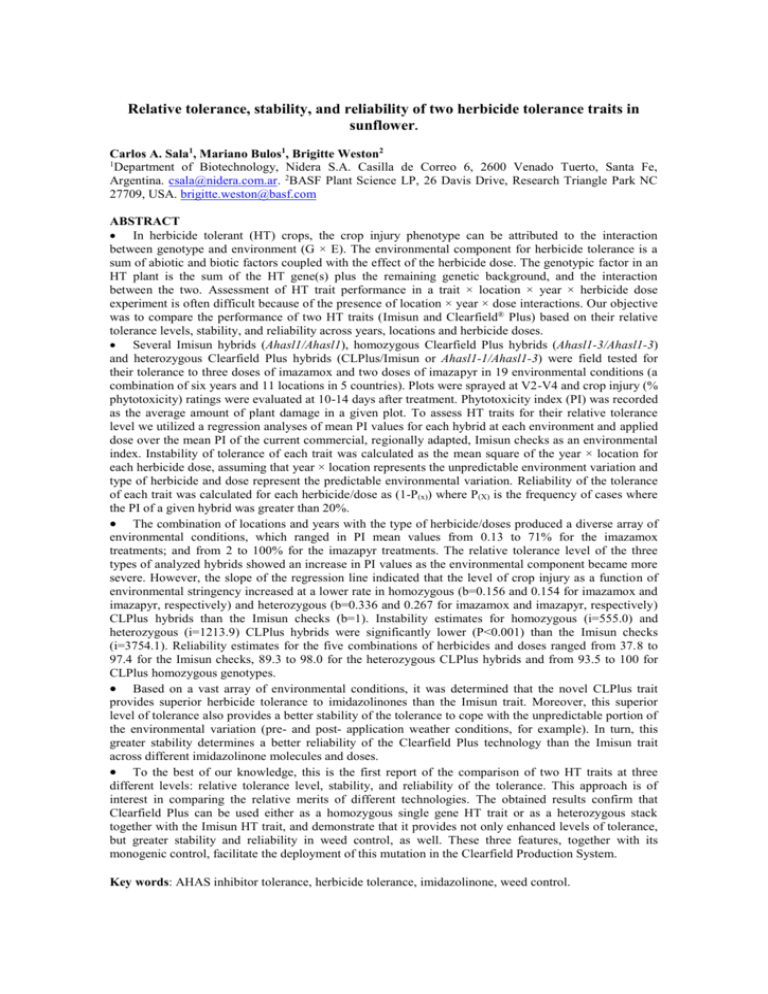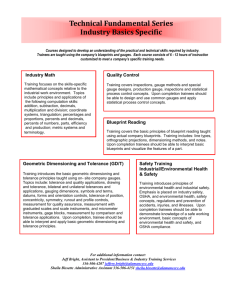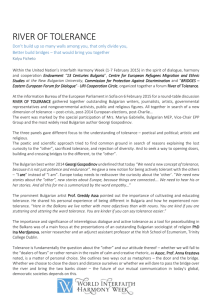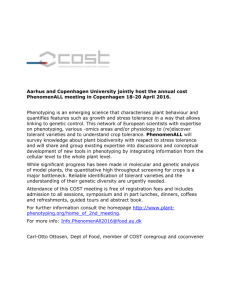Relative tolerance, stability and reliability of two herbicide
advertisement

Relative tolerance, stability, and reliability of two herbicide tolerance traits in sunflower. Carlos A. Sala1, Mariano Bulos1, Brigitte Weston2 1 Department of Biotechnology, Nidera S.A. Casilla de Correo 6, 2600 Venado Tuerto, Santa Fe, Argentina. csala@nidera.com.ar. 2BASF Plant Science LP, 26 Davis Drive, Research Triangle Park NC 27709, USA. brigitte.weston@basf.com ABSTRACT In herbicide tolerant (HT) crops, the crop injury phenotype can be attributed to the interaction between genotype and environment (G × E). The environmental component for herbicide tolerance is a sum of abiotic and biotic factors coupled with the effect of the herbicide dose. The genotypic factor in an HT plant is the sum of the HT gene(s) plus the remaining genetic background, and the interaction between the two. Assessment of HT trait performance in a trait × location × year × herbicide dose experiment is often difficult because of the presence of location × year × dose interactions. Our objective was to compare the performance of two HT traits (Imisun and Clearfield® Plus) based on their relative tolerance levels, stability, and reliability across years, locations and herbicide doses. Several Imisun hybrids (Ahasl1/Ahasl1), homozygous Clearfield Plus hybrids (Ahasl1-3/Ahasl1-3) and heterozygous Clearfield Plus hybrids (CLPlus/Imisun or Ahasl1-1/Ahasl1-3) were field tested for their tolerance to three doses of imazamox and two doses of imazapyr in 19 environmental conditions (a combination of six years and 11 locations in 5 countries). Plots were sprayed at V2-V4 and crop injury (% phytotoxicity) ratings were evaluated at 10-14 days after treatment. Phytotoxicity index (PI) was recorded as the average amount of plant damage in a given plot. To assess HT traits for their relative tolerance level we utilized a regression analyses of mean PI values for each hybrid at each environment and applied dose over the mean PI of the current commercial, regionally adapted, Imisun checks as an environmental index. Instability of tolerance of each trait was calculated as the mean square of the year × location for each herbicide dose, assuming that year × location represents the unpredictable environment variation and type of herbicide and dose represent the predictable environmental variation. Reliability of the tolerance of each trait was calculated for each herbicide/dose as (1-P(x)) where P(X) is the frequency of cases where the PI of a given hybrid was greater than 20%. The combination of locations and years with the type of herbicide/doses produced a diverse array of environmental conditions, which ranged in PI mean values from 0.13 to 71% for the imazamox treatments; and from 2 to 100% for the imazapyr treatments. The relative tolerance level of the three types of analyzed hybrids showed an increase in PI values as the environmental component became more severe. However, the slope of the regression line indicated that the level of crop injury as a function of environmental stringency increased at a lower rate in homozygous (b=0.156 and 0.154 for imazamox and imazapyr, respectively) and heterozygous (b=0.336 and 0.267 for imazamox and imazapyr, respectively) CLPlus hybrids than the Imisun checks (b=1). Instability estimates for homozygous (i=555.0) and heterozygous (i=1213.9) CLPlus hybrids were significantly lower (P<0.001) than the Imisun checks (i=3754.1). Reliability estimates for the five combinations of herbicides and doses ranged from 37.8 to 97.4 for the Imisun checks, 89.3 to 98.0 for the heterozygous CLPlus hybrids and from 93.5 to 100 for CLPlus homozygous genotypes. Based on a vast array of environmental conditions, it was determined that the novel CLPlus trait provides superior herbicide tolerance to imidazolinones than the Imisun trait. Moreover, this superior level of tolerance also provides a better stability of the tolerance to cope with the unpredictable portion of the environmental variation (pre- and post- application weather conditions, for example). In turn, this greater stability determines a better reliability of the Clearfield Plus technology than the Imisun trait across different imidazolinone molecules and doses. To the best of our knowledge, this is the first report of the comparison of two HT traits at three different levels: relative tolerance level, stability, and reliability of the tolerance. This approach is of interest in comparing the relative merits of different technologies. The obtained results confirm that Clearfield Plus can be used either as a homozygous single gene HT trait or as a heterozygous stack together with the Imisun HT trait, and demonstrate that it provides not only enhanced levels of tolerance, but greater stability and reliability in weed control, as well. These three features, together with its monogenic control, facilitate the deployment of this mutation in the Clearfield Production System. Key words: AHAS inhibitor tolerance, herbicide tolerance, imidazolinone, weed control. INTRODUCTION Weeds compete with sunflower for moisture, nutrients, and depending on species for light and space. Weed competition causes substantial yield losses in sunflower, with reports ranging from 20 to 70%. The amount of yield reduction varies depending on the weed species, weed density, time of weed and crop emergence, climatic conditions, and type of soil. Herbicides are the most desirable method for weed control; however, the availability of selective herbicides for the sunflower crop is quite limited and, due to the high cost of herbicide registration, new molecules of herbicides are unlikely to be specifically developed for weed control in this crop. For this reason, gene discovery and trait development for herbicide resistance in sunflower is one of the most important issues in raising the productivity and the competitive ability of this crop in the near future (Sala et al., 2012a). The imidazolinone family of herbicides control weeds by inhibiting a key enzyme in the branched chain amino acid biosynthetic pathway, acetohydroxyacid synthase (AHAS; EC 4.1.3.18) also known as acetolactate synthase (ALS) (Shaner et al., 1984; Tan et al., 2005). During the past decade two technologies of weed control that make use of imidazolinones and different mutations at the Ahasl1 locus were developed for sunflower. The Clearfield system is based on two genes (Ahasl1-1 and an enhancer, Tan et al., 2005), and the Clearfield Plus system, based on the allele Ahasl1-3 (Sala et al., 2008c). Ahasl11 (also known as Imr1 or Arpur, Bruniard and Miller 2001; Kolkman et al., 2004; respectively) harbors a C-to-T mutation in codon 205 (relative to Arabidopsis thaliana nomenclature) which confers a moderate tolerance to imidazolinones, and Ahasl1-3 has a G-to-A mutation in codon 122 which confers high levels of tolerance to imidazolinones (Sala et al., 2008b). The AHAS resistant alleles Ahasl1-1 and Ahasl1-3 showed significant differences in their response to imazapyr application, either in homozygous or heterozygous states. Genotypes carrying the Ahasl1-3 allele are more tolerant at the phenotypic (aboveground and root biomass accumulation under greenhouse conditions) and enzymatic levels than those carrying the Ahasl1-1 allele (Sala et al., 2011, 2012b) Dominance relationships at the Ahasl1 locus indicated that both resistant alleles are recessive with respect to the wildtype allele at the enzymatic level, but at the phenotypic level they varied from dominance to recessivity. Interestingly, Ahasl1-3 showed dominance over Ahasl1-1 both at the phenotypic and enzymatic levels and at all the tested doses, an observation that can be interpreted taking into account the multimeric protein structure of the AHAS catalytic subunit (Sala et al., 2011). In herbicide tolerant (HT) crops, the crop injury phenotype can be attributed to the interaction between genotype and environment (GxE). The environmental component for herbicide tolerance is a sum of abiotic and biotic factors coupled with the effect of the herbicide dose. The genotypic factor in an HT plant is the sum of the HT gene(s) plus the remaining genetic background, and the interaction between the two. Assessment of HT trait performance in a trait × location × year × herbicide dose experiment is often difficult because of the presence of location × year × dose interactions. Our objective was to compare the performance of two HT traits (Imisun and Clearfield® Plus) based on their relative tolerance levels, stability, and reliability across years, locations and herbicide doses. MATERIALS AND METHODS Ten Imisun hybrids (Ahasl1/Ahasl1), eight homozygous CLPlus hybrids (Ahasl1-3/Ahasl1-3) and eight heterozygous CLPlus hybrids (CLPlus/Imisun, Ahasl1-1/Ahasl1-3) were field tested for their tolerance to three doses of imazamox and two doses of imazapyr in 19 environmental conditions (a combination of six years and 12 locations in 5 countries, see Table 1). Table 1. Environments of evaluation including country, location and year. Country United States of America Argentina United States of America Argentina Argentina Argentina Argentina United States of America Location Velva Venado Tuerto Velva Laguna Blanca Venado Tuerto Balcarce San Geronimo Hickson Year 2005 2006 2006 2007 2007 2007 2007 2007 France France Argentina Paraguay United States of America Hungary Hungary United States of America France Hungary Hungary Angers Saintes Venado Tuerto Nueva Alborada Velva Hodmezovasarhely Gyor Velva Toulousse Hodmezovasarhely Gyor 2007 2007 2008 2008 2008 2008 2008 2009 2009 2010 2010 Experimental Imisun and CLPlus hybrids, as well as commercial Imisun and susceptible cultivars used as checks, were sown in each location as a completely randomized block design with three replications. Each plot consisted in four rows 6 m long and 0.7 m appart. Three out of the 4 rows were sprayed at V2-V4 stage of plant development (Schneiter and Miller, 1981) and the fourth row of each plot was used as an untreated control. Phytotoxicity Index (PI) was evaluated at 10-14 days after treatment and was recorded as the average amount of plant damage in a given plot in comparison with the untreated rows used as control. To assess Imisun and CLPlus traits for their relative tolerance level we utilized a regression analyses of mean PI values for each hybrid at each environment and applied dose over the mean PI of the current commercial, regionally adapted, Imisun checks as an environmental index (Sala et al., 2008a). Estimation of stability for each HT trait was based on type 4 stability parameter as defined by Lin and Binns (1998). Instability of tolerance of each trait was calculated as year × location mean square for each herbicide dose, assuming that year × location interaction represents the unpredictable environmental variation, and type of herbicide and dose represent the predictable part of the environmental variation. Estimation of reliability of the tolerance for each HT trait was based on the definitions given by Eskridge and Mumm (1992) and was calculated for each combination of herbicide and dose as (1-P(x)) where P(X) is the frequency of cases where the PI of a given hybrid was greater than 20%. RESULTS The combination of locations and years with the type of herbicide/doses produced a diverse array of environmental conditions, which ranged in PI mean values from 0.13 to 71% for the imazamox treatments; and from 2 to 100% for the imazapyr treatments. The relative tolerance level of the three types of hybrids ―Imisun, homo, and heterozygous stacked CLPlus experimental hybrids― showed an increase in PI as the environmental component became more severe (Fig. 1 and 2). However, the slope of the regression line indicated that the level of crop injury as a function of environmental stringency increased at a lower rate in homozygous (b=0.156 and 0.154 for imazamox and imazapyr, respectively) and heterozygous (b=0.336 and 0.267 for imazamox and imazapyr, respectively) Clearfield Plus hybrids than the Imisun checks (b=1). Average tolerance instability estimates for homozygous (i=555.0) and heterozygous (i=1213.9) Clearfield Plus hybrids were significantly lower (P<0.001) than for the Imisun checks (i=3754.1). Moreover, in Fig.3 it can be observed that when the instability of the tolerance is plotted against an index reflecting the environmental stringency (mean PI of the current commercial, regionally adapted, Imisun checks for each one of the five combinations of herbicides and doses used) the instability of the tolerance for the Imisun hybrids showed an exponential increase while the instability of the tolerance of the CLPlus hybrids increased linearly as the environmental severity intensifies. In fact, the maximum value for the instability of the tolerance for the CLPlus homozygous hybrids (i=919.4) is lesser than the minimum value of tolerance instability for the Imisun hybrids (i=1219.2, Fig. 3). Estimates of the reliability of the tolerance for the five combinations of herbicides and doses used ranged from 37.8 to 97.4% for the Imisun checks, from 89.3 to 98.0% for the heterozygous Clearfield Plus hybrids and from 93.5 to 100% for Clearfield Plus homozygous genotypes. In fact, reliability of the tolerance for the Imisun hybrids significantly decreased (P<0.001) as the imazapyr or imazamox doses increased (Fig. 4). For both types of CLPlus hybrids, on the other hand, reliability of tolerance only decreases significantly (P<0.05) at the higher doses of both herbicides (Fig. 4). Fig.1. Relative tolerance level of Imisun and CLPlus hybrids when challenged with different doses of imazamox under a vast array of environmental situations. Fig.2. Relative tolerance level of Imisun and CLPlus hybrids when challenged with different doses of imazapyr under a vast array of environmental situations. Fig. 3. Instability estimates of Imisun and CLPlus hybrids when challenged with different doses of imazamox and imazapyr under diverse environmental situations. Fig. 4. Average estimates of reliability of the tolerance for different CLPlus and Imisun hybrids when exposed to five combinations of imidazolinones and doses. DISCUSSION Based on a vast array of environmental conditions, it was determined that the novel Clearfield Plus trait provides superior herbicide tolerance to imidazolinones than the Imisun trait. This superior herbicide tolerance across different environmental conditions of the CLPlus trait is associated with its lower level of AHAS enzymatic inhibition when challenged with increased doses of imazapyr in vitro (Sala el al., 2011). Moreover, this superior level of tolerance also provides a better stability of the tolerance to cope with the unpredictable portion of the environmental variation (pre- and post- application weather conditions for example). In turn, this greater stability determines a better reliability of the Clearfield Plus technology than the Imisun trait across different imidazolinone molecules and doses. Better stability and reliability of the CLPlus trait can be explained by its higher tolerance at the enzymatic level and also because its tolerance is solely based in a target-site system. By the contrary, the tolerance of the Imisun trait is based both on a target (the AHAS enzyme) and on a non-target system of detoxification (Sala et al., 2012c). Given that this later system is environmentally labile, the whole system is less stable across different environmental situations. To the best of our knowledge, this is the first report of the comparison of two HT traits at three different levels: relative tolerance level, stability, and reliability of the tolerance. This approach is of interest in comparing the relative merits of different technologies. The obtained results confirm that Clearfield Plus can be used either as a homozygous single gene HT trait or as a heterozygous stack together with the Imisun HT trait as was reported previously (Sala et al., 2008a, 2011), and demonstrate that it provides not only enhanced levels of tolerance, but also a greater stability and reliability in weed control, as well. These three features, in addition with its monogenic control, facilitate the deployment of this mutation in the Clearfield Production System. REFERENCES Bruniard J.M., and J.F. Miller. 2001. Inheritance of imidazolinone herbicide resistance in sunflower. Helia 24:11–16. Eskridge, K.M. and R.F Mumm. 1992. Choosing plant cultivars based on the probability of outperforming a check. Theor. Appl. Genet. 84:494-500. Kolkman J.M., M.B. Slabaugh, J.M. Bruniard, B. Berry, B.S. Bushman, C. Olungu, N. Maes, G. Abratti, A. Zambelli, J.F. Miller, A. Leon, S.J. Knapp. 2004. Acetohydroxyacid synthase mutations conferring resistance to imidazolinone or sulfonylurea herbicides in sunflower. Theor. Appl. Genet. 109:1147–1159. Lin, C.S. and M.R. Binns. 1988. A method of analyzing cultivar × location × year experiments: A new stability parameter. Theor. Appl. Genet. 76:425–430. Sala, C.A, M. Bulos, A.M Echarte, S. Whitt, G. Budziszewski, W. Howie, B. Singh and B. Weston. 2008a. Development of CLHA-Plus: a novel herbicide tolerance trait in sunflower conferring superior imidazolinone tolerance and ease of breeding. p. 489–494. In: Proc. 17th Int. Sunflower Conf., Córdoba, Spain. 8-12 Jun. 2008. Int. Sunfl. Assoc., Paris, France. Sala, C.A., M. Bulos, and A.M. Echarte. 2008b. Genetic analysis of an induced mutation conferring imidazolinone resistance in sunflower. Crop Sci. 48:1817–1822 Sala, C.A., M. Bulos, A.M. Echarte, S.R. Whitt, and R. Ascenzi. .2008c. Molecular and biochemical characterization of an induced mutation conferring imidazolinone resistance in sunflower. Theor. Appl. Genet. 108:105–112 Sala, C.A., M. Bulos, E. Altieri and B. Weston. 2011. Response to imazapyr and dominance relationships of two imidazolinone-tolerant alleles at the Ahasl1 locus of sunflower. Theor. Appl. Genet. (in press). Doi: 10.1007/s00122-011-1713-6 Sala, C.A., M. Bulos, E. Altieri and M.L. Ramos. 2012a. Sunflower: improving crop productivity and abiotic stress tolerance. In: N. Tuteja, S. Gill, A.F. Tubercio, R. Tuteja (eds) Improving crop resistance to abiotic stress. Wiley-Blackwell Wiley-VCH Verlag GmbH & Co., Germany (in press) Sala, C.A., M. Bulos, E. Altieri, and M.L. Ramos. 2012b. Root biomass response to foliar application of imazapyr for two imidazolinone tolerant alleles of sunflower (Helianthus annuus L.). Breeding Science (in press) Sala C.A., M. Bulos, E. Altieri, and M.L. Ramos. 2012c. Imisun tolerance is the result of the interaction between target and non-target tolerance mechanisms. In: Proc. 18th Int. Sunflower Conf., Mar del Plata and Balcarce, Argentina, Feb 27- March 1. 2012. Shaner D.L., P.C. Anderson, and M.A. Stidham. 1984. Imidazolinones: potent inhibitors of acetohydroxyacid synthase. Plant Physiol. 76:545–546 Tan S., R.R. Evans, M.L. Dahmer, B.K. Singh, D.L. Shaner. 2005. Imidazolinone-tolerant crops: history, current status and future. Pest Manag. Sci. 61:246–257







